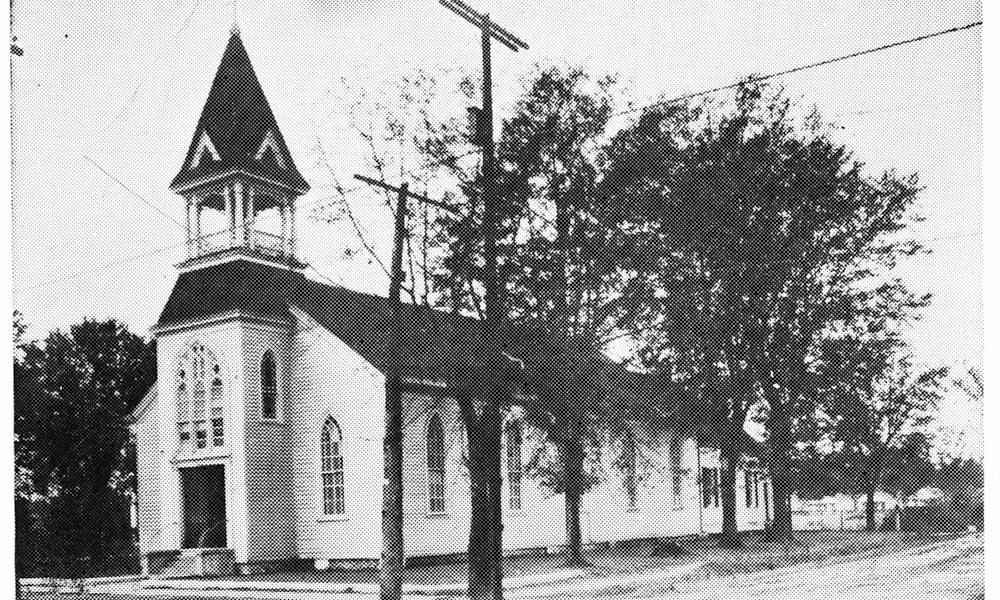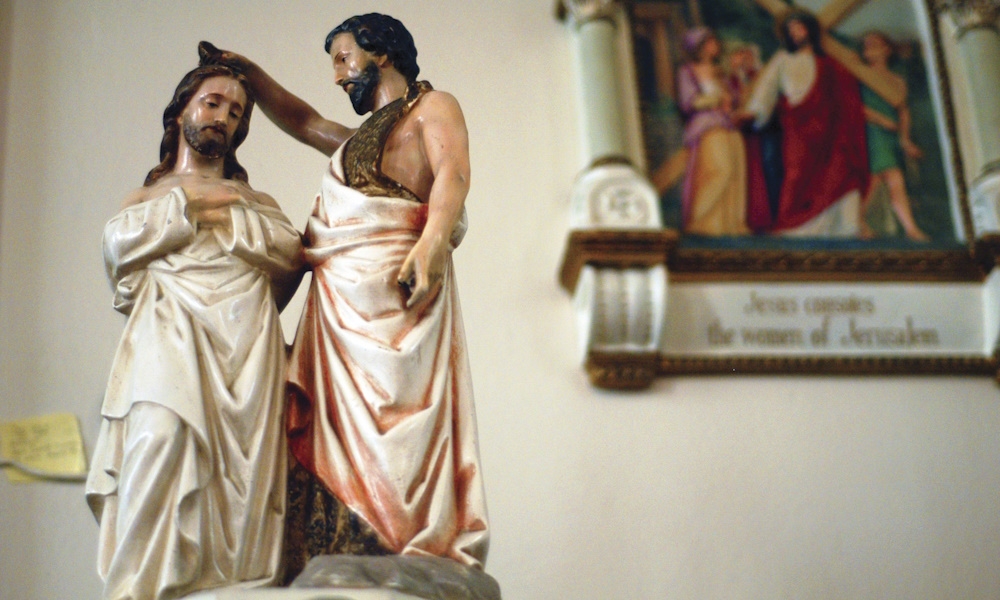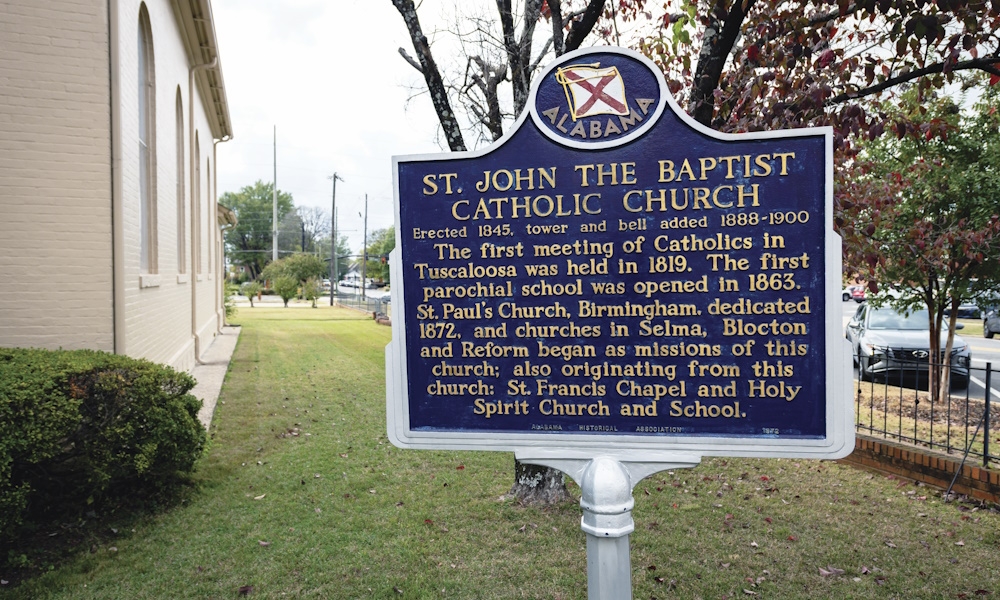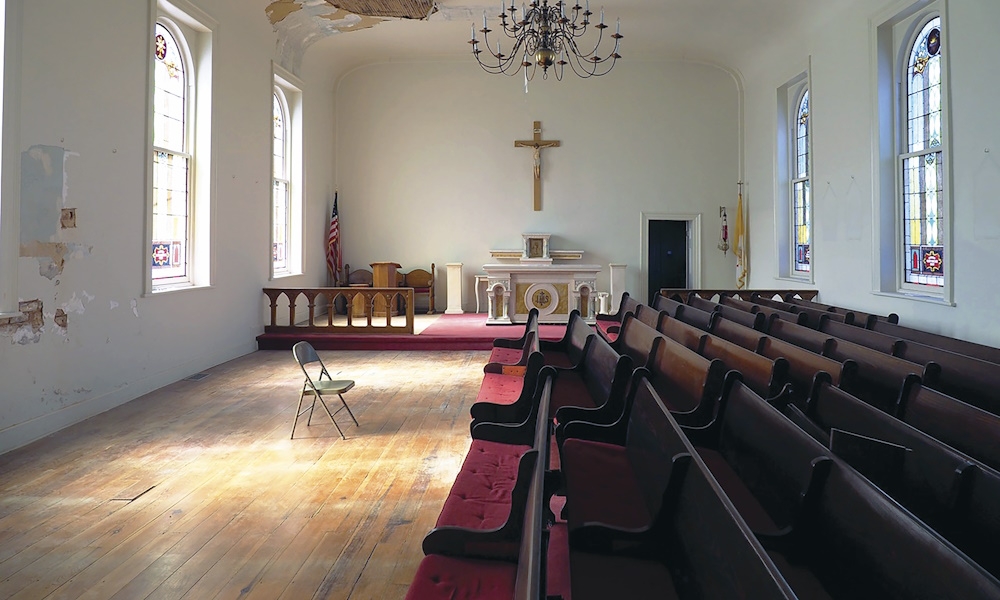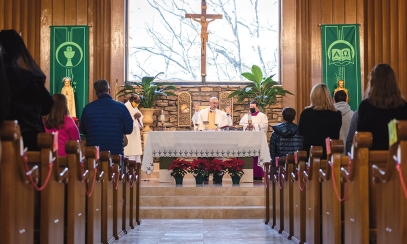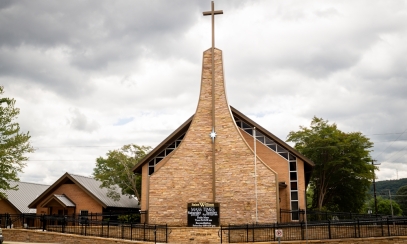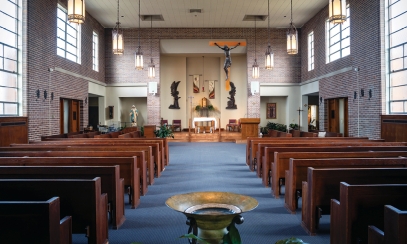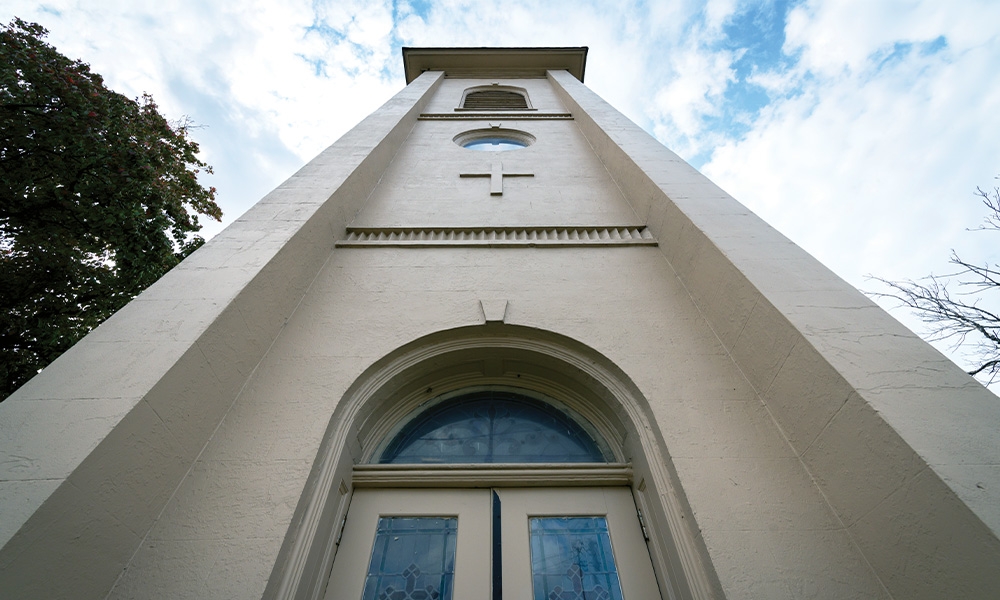
St. John the Baptist Catholic Church, Tuscaloosa
Exactly one day before Alabama was admitted to the Union as a state on Dec. 14, 1819, Tuscaloosa was incorporated as a town. At that time, there was nary a church in what is now known as the Diocese of Birmingham in Alabama, but there was a diminutive yet zealous Catholic population, which consisted of many Irish and French immigrants. The faithful longed for the sacraments, and it is said that the first Catholic Mass in this area also took place in 1819.
Exactly one day before Alabama was admitted to the Union as a state on Dec. 14, 1819, Tuscaloosa was incorporated as a town. At that time, there was nary a church in what is now known as the Diocese of Birmingham in Alabama, but there was a diminutive yet zealous Catholic population, which consisted of many Irish and French immigrants. The faithful longed for the sacraments, and it is said that the first Catholic Mass in this area also took place in 1819.
Almost 10 years later, Pope Pius VIII would officially erect the Diocese of Mobile on May 9, 1829. Shortly after becoming the new diocese’s shepherd, Bishop Michael Portier directed two priests to tour the northern part of Alabama. At that time, Tuscaloosa was the state capital, but the Catholic population was still rather small in comparison, with only 35 Catholics recorded. Nonetheless, they banded together and advocated for a parish.
As the year 1844 began, so did St. John the Baptist Parish. The parish was established in January and construction on the 31’ x 55’ church building was completed in 1845 for a mere $2,800. Amazingly, besides Bishop Portier, two Methodist ministers, a Baptist minister, a judge, the governor, the president of the University of Alabama, and many others contributed to the building fund. On Jan. 25, 1846, Bishop Portier dedicated St. John’s.
By 1847, Montgomery had become the State Capital, and with that move, Tuscaloosa lost a fair number of inhabitants. The parish history states Father Albin Desgaultiere was made pastor that year, but his departure date is contested. Regardless of his actual reassignment date, St. John’s was without a pastor until a newly ordained priest by the name of Michael Dougherty was appointed pastor in 1857. Sadly, the young priest collapsed after reading the Passion during Lent in 1858. He would die a few days later and be buried “on the front lawn of the church.”
After the pastor’s untimely demise, the parish was once again without a pastor. The next pastor, Father Dominic Manucy, arrived in 1860, with the next priest, Father Timothy J. M. Murphy, arriving in 1862. In the height of the Civil War, Father Murphy opened a school, but it was closed the very next year.
As the War between the States concluded, the parish’s next pastor, a 23-year-old priest, would conduct one of his first acts as pastor by accompanying Tuscaloosa’s mayor to surrender the town to the Federal Army on April 4, 1865. The young Father William F. McDonough asked Gen. John T. Croxton to spare his new parish from “robbery, pillage, and looting.” The persuasive priest was successful, and the general placed guards around the church property during the Union occupation.
Following Father McDonough’s pastorate, Fathers Edward Kerwin, William Hamilton, and Joseph G. J. Crowley would serve as pastor, respectively. In 1880, Father McDonough returned as pastor of the Tuscaloosa parish and found the school, which he had opened in 1866, closed. The next in line to serve as pastor was Father John Cassidy. After four years, Father James P. McCafferty arrived and stayed as pastor for 12 years. During his tenure, the priest would reopen the school, direct a restoration project, build a rectory, and mark the parish’s 50th anniversary.
After the turn of the century, Fathers M. J. Cunningham, Thomas Cassidy, A. L. Sweeney, Eugene L. Sands, and Thomas A. Lenahan would all take their turns leading the parish. It was Father Lenahan who, in 1920, brought the Sisters of Loretto to Tuscaloosa to help run the school, which had been closed for 31 years. Under his leadership, the parish flourished as it was involved in many community and civic activities, including support for students at the University of Alabama, ministering to patients at Bryce Mental Hospital, running a hospice for the aged and infirm members of the black community, distributing food and clothing to the needy, and providing free tuition for school children.
Father Lenehan’s mother even donated the lot on which Bishop Thomas J. Toolen, then Bishop of the Diocese of Mobile, would have St. Francis Chapel erected.
In 1929, the care of St. John’s was transferred to the Holy Ghost Fathers. Father Anthony Hackett, C.S.Sp., was the first of the order’s priests to take charge of the parish. The next 11 years saw further improvements to the church property and the Benedictine Sisters taking charge of the parish’s school. The next Holy Ghost Fathers to serve as pastor were Fathers Michael F. Mulvoy, Eugene McGrugin, Edward Beriault, and J. J. Cassidy.
During the last year of Father Beriault’s pastorate, Bishop Toolen approved plans to build a new church and school, and under Father Cassidy’s leadership, Holy Spirit Catholic Church and School were built, with the formal dedication of the church taking place in January of 1965. In anticipation of the new school, which was opened in 1962, Father Cassidy closed St. John’s School in 1961.
On Aug. 20, 1971, the parish was transferred back to the diocese. It is believed that at this time, St. John’s became the mission of Holy Spirit Catholic Church, with Father MacPaul Abraham as the pastor. The 1970s saw the church building on the precipice of demolition, but Father Michael White, Father Abraham’s successor, stepped in and spearheaded an extensive restoration project, which included exposing and refinishing the original wood floor, making the belfry safe again, and removing and repairing the 80-year-old stained glass windows.
On June 12, 1975, the Alabama Historical Commission added St. John’s to the Alabama Register of Landmarks and Heritage, and the church was re-dedicated on June 24, 1977, the feast of St. John the Baptist.
Father White was followed by Fathers Francis Cravens and John Fallon. Under Father Fallon, the parish not only began offering a Spanish Mass once a month for local members of the Hispanic community, but it also marked its 150th anniversary. Father Jeremiah Deasy was next up to serve as pastor, followed by Msgr. Michael Deering, who began his pastorate in 2016.
Just a few short years later in December of 2019, Msgr. Deering was praying what would ultimately be the last Mass to date at St. John’s. COVID-19 effectively shut down the church. Plans were made to reopen in mid-2021; however, in August of that year, the plaster ceiling collapsed.
In an effort to keep the church open and preserve such an important part of Catholic history in the state, a restoration project was organized. In a letter to his parishioners, Msgr. Deering wrote: “Unfortunately, time has taken its toll on this beloved church. St. John’s needs immediate attention and ongoing care to reclaim its beauty and ensure its continuing soundness.” With that appeal, money was collected, and the ceiling and flooring were repaired late last year. A new air conditioning system was also installed to address moisture issues, preventing future damage to the interior. With glory to God, the “mother church” of the diocese is set to reopen to the faithful in the summer of this year.
With St. John’s reopening, the words of Thomas Clinton, the son of a man who helped build the original church, written in 1922, will be honored: “I hope and implore that the hallowed memories of this dear old parish will not be forgotten. … Let the shades of Father Hackett and Father Dougherty and Bishop Portier be revered, and the record of the saintly lives of such zealous souls as Father Murphy, Father McDonough, Father McCafferty, and a number of others be handed down to posterity. Let the memories of the ancient patriarchs be kept alive, and their footprints in the sands of time, be an inspiration to both clergy and laity in the uplift of man.”
To join in the effort of restoring and preserving St. John’s, please consider making a donation to cover the final costs of restoration and to establish an endowment that will fund the maintenance and operation of the church for generations to come. To learn more, please visit hschurch.com.

